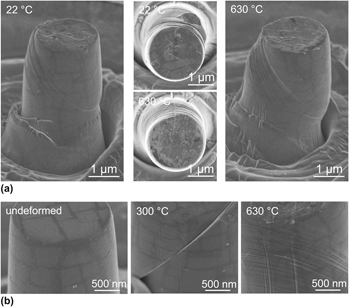Crossref Citations
This article has been cited by the following publications. This list is generated based on data provided by
Crossref.
Wheeler, J.M.
Brodard, P.
and
Michler, J.
2012.
Elevated temperature,in situindentation with calibrated contact temperatures.
Philosophical Magazine,
Vol. 92,
Issue. 25-27,
p.
3128.
Smith, J. F.
Vishnyakov, V. M.
Davies, M. I.
and
Beake, B. D.
2013.
Nanoscale Friction Measurements Up to 750 °C.
Tribology Letters,
Vol. 49,
Issue. 3,
p.
455.
Wheeler, J.M.
Niederberger, C.
Tessarek, C.
Christiansen, S.
and
Michler, J.
2013.
Extraction of plasticity parameters of GaN with high temperature, in situ micro-compression.
International Journal of Plasticity,
Vol. 40,
Issue. ,
p.
140.
Schneider, A.S.
Frick, C.P.
Arzt, E.
Clegg, W.J.
and
Korte, S.
2013.
Influence of test temperature on the size effect in molybdenum small-scale compression pillars.
Philosophical Magazine Letters,
Vol. 93,
Issue. 6,
p.
331.
Palacio, Manuel L.B.
and
Bhushan, Bharat
2013.
Depth-sensing indentation of nanomaterials and nanostructures.
Materials Characterization,
Vol. 78,
Issue. ,
p.
1.
Wheeler, J. M.
and
Michler, J.
2013.
Elevated temperature, nano-mechanical testing in situ in the scanning electron microscope.
Review of Scientific Instruments,
Vol. 84,
Issue. 4,
Lee, H.
Chen, Y.
Claisse, A.
and
Schuh, C.A.
2013.
Finite Element Simulation of Hot Nanoindentation in Vacuum.
Experimental Mechanics,
Vol. 53,
Issue. 7,
p.
1201.
Wheeler, J. M.
and
Michler, J.
2013.
Invited Article: Indenter materials for high temperature nanoindentation.
Review of Scientific Instruments,
Vol. 84,
Issue. 10,
Wheeler, J.M.
Raghavan, R.
Chawla, V.
Morstein, M.
and
Michler, J.
2014.
Deformation of Hard Coatings at Elevated Temperatures.
Surface and Coatings Technology,
Vol. 254,
Issue. ,
p.
382.
Cheng, I. C.
Garcia-Sanchez, E.
and
Hodge, A. M.
2014.
Note: A method for minimizing oxide formation during elevated temperature nanoindentation.
Review of Scientific Instruments,
Vol. 85,
Issue. 9,
Beake, B.D.
and
Fox-Rabinovich, G.S.
2014.
Progress in high temperature nanomechanical testing of coatings for optimising their performance in high speed machining.
Surface and Coatings Technology,
Vol. 255,
Issue. ,
p.
102.
Göken, M.
2014.
Moderne Methoden der WerkstoffprüFung.
p.
299.
Chen, Jian
Beake, Ben D.
Dong, Hanshan
and
Bell, Gerard A.
2014.
Nanomechanical Analysis of High Performance Materials.
Vol. 203,
Issue. ,
p.
63.
Amodeo, J.
Begau, C.
and
Bitzek, E.
2014.
Atomistic Simulations of Compression Tests on Ni3Al Nanocubes.
Materials Research Letters,
Vol. 2,
Issue. 3,
p.
140.
Di Gioacchino, Fabio
and
Clegg, William John
2014.
Mapping deformation in small-scale testing.
Acta Materialia,
Vol. 78,
Issue. ,
p.
103.
Messé, O. M. D. M.
Stekovic, S.
Hardy, M. C.
and
Rae, C. M. F.
2014.
Characterization of Plastic Deformation Induced by Shot-Peening in a Ni-Base Superalloy.
JOM,
Vol. 66,
Issue. 12,
p.
2502.
Beake, Ben
Harris, Adrian
and
Liskiewicz, Tomasz
2015.
Materials Characterization.
p.
1.
Primorac, Mladen-Mateo
Abad, Manuel David
Hosemann, Peter
Kreuzeder, Marius
Maier, Verena
and
Kiener, Daniel
2015.
Elevated temperature mechanical properties of novel ultra-fine grained Cu–Nb composites.
Materials Science and Engineering: A,
Vol. 625,
Issue. ,
p.
296.
Wheeler, J.M.
Armstrong, D.E.J.
Heinz, W.
and
Schwaiger, R.
2015.
High temperature nanoindentation: The state of the art and future challenges.
Current Opinion in Solid State and Materials Science,
Vol. 19,
Issue. 6,
p.
354.
Maier, Verena
Leitner, Alexander
Pippan, Reinhard
and
Kiener, Daniel
2015.
Thermally Activated Deformation Behavior of ufg-Au: Environmental Issues During Long-Term and High-Temperature Nanoindentation Testing.
JOM,
Vol. 67,
Issue. 12,
p.
2934.
